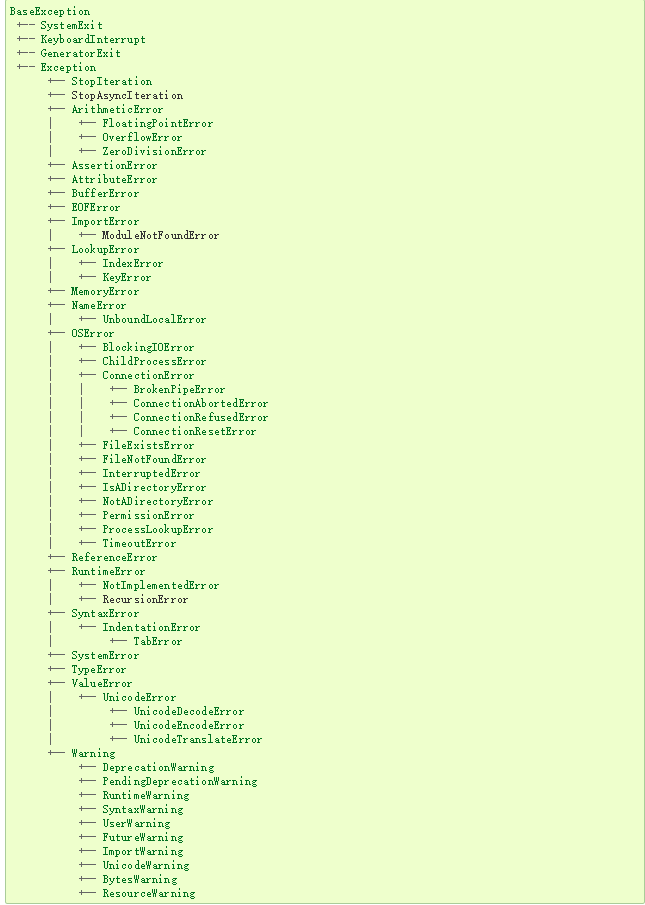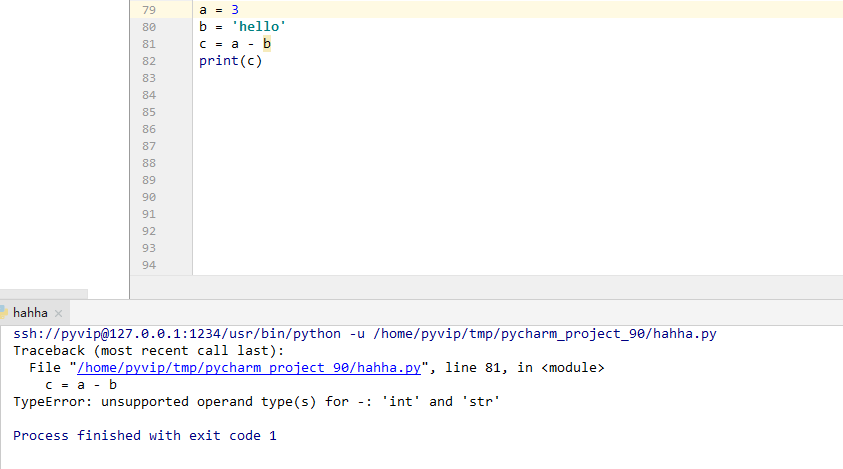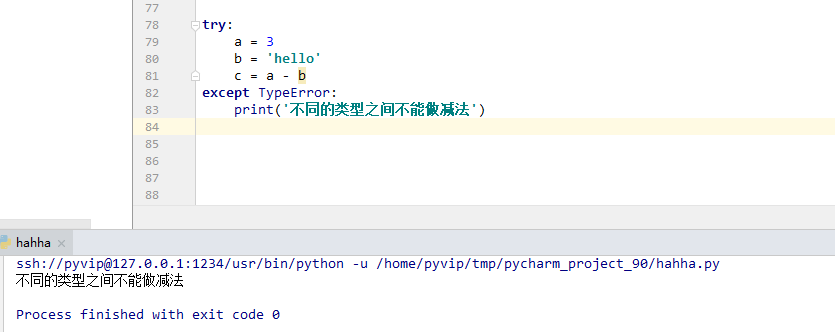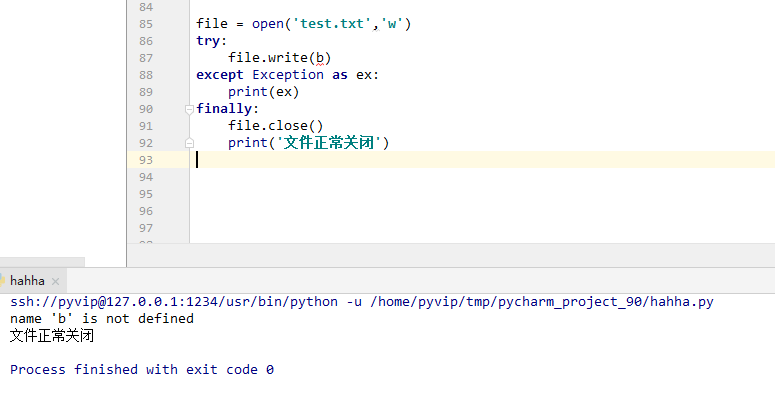1. 认识异常
help(TypeError)
class TypeError(Exception)
| Inappropriate argument type.
|
| Method resolution order:
| TypeError
| Exception
| BaseException
| object
|
| Methods defined here:
|
| __init__(self, /, *args, **kwargs)
| Initialize self. See help(type(self)) for accurate signature.
|
| __new__(*args, **kwargs) from builtins.type
| Create and return a new object. See help(type) for accurate signature.
|
| ----------------------------------------------------------------------
| Methods inherited from BaseException:
|
| __delattr__(self, name, /)
:
- 错误类型其实都是类的实例;TypeError是继承Exception的,把Exception叫做父类或者基类。
1.1 Python的异常结构
https://docs.python.org/3/library/exceptions.html#exception-hierarchy 从官网截图如下:

在python中的所有异常都是继承自BaseException。BaseException直接分为四大类:
- SystemExit : Python退出异常
- KeyboardInterrupt: 键盘打断异常(Ctrl + C)
- GeneratorExit :生成器退出异常
- Exception :普通异常(只会使用这部分的异常)
1.2 try … except
用try … except 捕获异常
try:
f = open('test.py','r')
except:
print('发生了异常')
执行上面代码的结果为:
发生了异常
例子2:
try:
x = 0
y = 1/x
except:
print('发生了异常')
执行上面代码的结果为:
发生了异常
1.2.2 捕获具体的异常
try:
f = open('test.py','r')
except FileNotFoundError:
print('发生了异常') # 当文件不存在的时候就会打印
执行上面代码的结果为:
发生了异常
try:
x = 0
y = 1/x
except FileNotFoundError:
print('发生了异常') # 会抛出ZeroDivisionError异常
执行上面代码的结果为:
Traceback (most recent call last):
File "/home/pyvip/tmp/pycharm_project_90/hahha.py", line 45, in <module>
y = 1/x
ZeroDivisionError: division by zero
1.2.3 捕获多种异常
例子1:
执行上面代码的结果为:
请输入正确的文件路径
例子2:
try:
x = 0
y = 1/x
except FileNotFoundError:
print('请输入正确的文件路径')
except ZeroDivisionError:
print('分母不能为0')
except Exception:
print('其他的普通异常')
代码的执行结果为:
分母不能为0
1.3 raise
raise是主动抛出异常,就是没有异常的也可以抛出异常。
执行上面代码的结果为:
Traceback (most recent call last):
File "/home/pyvip/tmp/pycharm_project_90/hahha.py", line 32, in <module>
raise TypeError('我就想您报错') # 主动抛出错误
TypeError: 我就想您报错
1.3.2 更加丰富的结构
- else,finnaly都是可以加到异常处理里面去的
- else是没有异常的时候会被执行掉
-
finnaly不管有没有异常都会被执行掉
try: x = 0 except Exception: print(‘发生了普通异常’) # 不打印 else: print(‘没有发生异常’) # 打印 finally: print(‘怎么都会执行’) # 打印
执行上面代码的结果为:
没有发生异常
怎么都会执行
注意:
不是所有的异常都可以捕获到的
如下面这种情况:
try:
print(‘Hello World')
except SyntaxError as e:
print(e)
执行上面的代码运行的结果为:
print(‘Hello World')
^
SyntaxError: invalid character in identifier
语法错误,属于Exception里面的,但是却捕获不到。
2. 断言
In [1]: a = 2
In [2]: b = 4
In [3]: a > b
Out[3]: False
In [4]: a < b
Out[4]: True
In [5]: assert a == b
---------------------------------------------------------------------------
AssertionError Traceback (most recent call last)
<ipython-input-5-46f3032e8f4c> in <module>()
----> 1 assert a == b
AssertionError:
In [6]: assert a > b
---------------------------------------------------------------------------
AssertionError Traceback (most recent call last)
<ipython-input-6-418b25926324> in <module>()
----> 1 assert a > b
AssertionError:
In [7]: assert a < b
当条件为真的时候就执行上面。
raise 与 assert 的区别:
raise 是主动抛出异常,就是没有异常的也可以抛出异常;而assert是当条件不满足是抛出异常。
3. 习题
3.1 自己构造一个报错的场景,并模仿上面的例子进行一个报错分析。

错误原因:是整型和字符串类型之间不能做减法的操作。
用try . . . except捕获异常

3.2 结合异常处理,确保打开文件后的正常关闭。
如果我用w模式正常打开文件,然后write时候如果报错呢?那么我怎么正常关闭文件?
